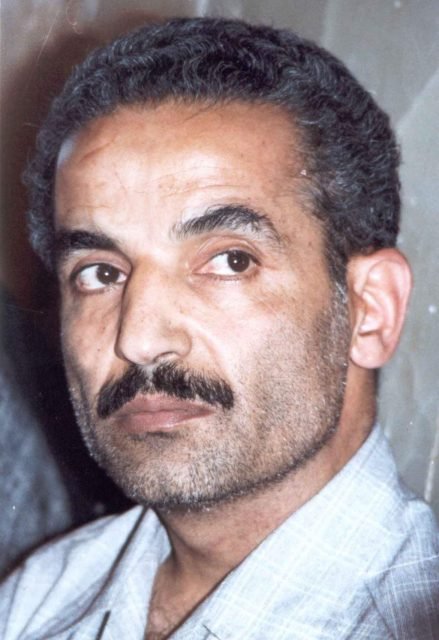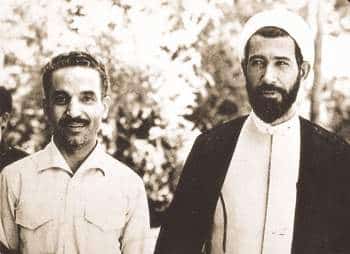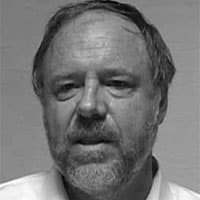
Introduction by Kevin Barrett, VT Editor
Thirty-four years ago – on August 30th, 1981 – a bloodthirsty terrorist group assassinated the most popular President in history. You say you haven’t heard about it? Maybe that’s because it was “their” president … and “our” terrorists.
The MEK terrorists who murdered Iranian President Rajai (and thousands of other Iranians) still enjoy the protection and support of Western authorities. As the West moves to normalize relations with Iran in the wake of the P5+1 nuclear deal, accept the existence and legitimacy of the Islamic Republic, and cooperate against takfiri terrorists including ISIL, maybe it’s time to declare an “information war on terrorism.” It’s long past time to tell the truth about terrorism: Beginning with the undeniable fact that the vast majority of terrorism since World War II has been perpetrated or supported by Western governments.
For the bloody details, read On Western Terrorism by Vltchek and Chomsky, which puts the death toll from Western terrorism at roughly 60 million since World War II. William Blum’s Killing Hope fills in key details and documentation. And my own Questioning the War on Terror (endorsed by Blum and other luminaries) deconstructs the received notion of “terrorism” by asking the hard questions.
So as we mourn President Rajai, let’s spread the truth about terrorism – and work to stop such things from ever happening again. -KB

The President who was Assassinated
An Essay about Mohammad Ali Rajāī, the second President of [the Islamic Republic of] Iran. Written by the editors at the monthly magazine Rāh, which is the organ of the Cultural Front of the Islamic Revolution of Iran, on the occasion of the martyrdom of Shahīd Rajāī. Translated by Arash Darya-Bandari
__________________________
On the 8th of Shahrīvar 1360 (30 August 1981), at around three in the afternoon, the tremendous sound of an explosion shocked the residents of Tehran. The country was at war and Saddam’s warplanes targeted a different area of the city every day, but the explosion of the 8th of Shahrīvar was different. A large pall of smoke rose up in the Tehran sky and people rushed toward where the smoke and flames were jetting out. It was the Prime Ministry building that had exploded and was being consumed in the fire that ensued.
The first question that was on the anxious minds of the people concerned the well-being of President Rajāī and Prime Minister Bāhonar. 39 days earlier, Rajāī had gained the votes of the majority of Iranians in an early election and had become the second President of the Islamic Republic of Iran, after Abol-Hasan Banī-Sadr who had fled to Europe after being removed from his post by the Majles (parliament).
After his dismissal from the presidency, Bani-Sadr’s supporters within the militia group of the Mojāhedīn-e Khalq Organization (MKO, which later came to be known as the Hypocrites), officially declared war on the Islamic Republic and attempted to seize power by means of targeted assassination and random acts of terror. On the 7th of Tīr, 1360 (28 June 1981) a large number of parliamentarians, academics and revolutionary leaders including Dr. Mohammad Beheshtī were killed when a large explosion destroyed the headquarters building of the Islamic Republic Party.
It had only been two months since that terrorist attack when the president and prime minister were assassinated. On the 8th of Shahrīvar 1360 (30 August 1981) there was a session of the National Security Council which was attended by the president, prime minister and other high officials. One of the members of the Mojāhedīn-e Khalq Organization (the Hypocrites) had managed to sneak a bomb into the building and to leave shortly thereafter, thereby ensuring that the flames of their counter-revolutionary hatred would arise from the Prime Minister’s office as well.
Mohammad Ali Rajāī had won the presidency after having earlier gained popularity among the people during his tenure in the office of Prime Minister. Prime Minister Rajāī’s simple life-style, his popular policies, and his authority and effectiveness provoked the envy of the West-oriented President (Banī-Sadr) to the point where the latter would openly malign his Prime Minister on numerous occasions in an effort to drive him away from the government.
But the support of the people and the Majles (parliament) precluded the success of these efforts. Unlike Banī-Sadr, who had returned to Iran after the victory of the revolution, having lived in Paris for many years while the revolution was taking shape, Rajāī was a revolutionary with a long record of struggle against the regime of the Shah which included having been arrested and imprisoned and tortured in the dungeons of that regime on numerous occasions.
Although he was a teacher (and not a member of the clergy), he struggled for the liberation of the country from the domination of the United States with a special devotion and love toward Imām Khomeinī. He was arrested for the first time in 1342 (1963) by SAVAK (the Shah’s secret police) and imprisoned for fifty days, and re-entered the field of battle upon his release.
When he was arrested again in 1353 (1974), it took four years before he gained his freedom. During this time, no effort was spared to get him to confess to working with (and giving up the names of) his co-conspirators. He spend nearly twenty months in solitary confinement, which is a span of time that is rarely used for solitary confinement (which is a form of torture) and which was reserved for special cases of hardened revolutionaries. When this treatment met with failure, they transferred Shahīd Rajāī to the Anti-Subversion Taskforce and subjected him to the harshest possible tortures:
“The year that I underwent [the tortures of] the Taskforce was truly a living Hell where they would beat me for twenty days on end without even bringing up what it was that they wanted, saying only things like “Start talking!” or they would double me over (as if I was bowed down in prayer) and tie my head to my feet and tell me to run in place, or they would tie me to a post and suspend me until I talked. I endured this treatment day and night for fourteen months.”
The effects of this torture remained on Shahīd Rajāī’s body for years. He carried these effects with him to the United Nations as living evidence of what he had endured and when he was being interviewed by journalists who had gathered there on the occasion of a meeting of the Security Council and asked him about the condition in which the US hostages were being treated, he took off his shoes and socks, put his feet on the table and said:
“For several years I was the prisoner of Carter and the United States in the torture dungeons of the accursed Shah; the effects of the torture that I was subjected to can still be seen after four years… For two straight years, I felt the blows of Carter’s whips on the soles of my feet, but this notwithstanding, we treat the hostages from the Den of Spies perfectly humanely.”
This trip was in Mehr of 1359 (September 1980). In those days, Rajāī was the Prime Minister of the Islamic Republic of Iran, and appeared as its first high-ranking official to give a speech about Iraq’s invasion of Iran. He endeavored to reveal what was taking place behind the scenes of Saddam’s invasion of Iran, and exposed the role or the United States and its allies in the invasion.
Rajāī’s speech was at one and the same time a bestowal of glad tidings to the oppressed and downtrodden of the world, a plaintiff call for justice and restitution, and the announcement of the revolution’s intention to continue its resistance and struggle in the international arena:
“Let the deprived and downtrodden people of the world and all those who have suffered at the hands of the hegemonic powers of East and West know that our Islamic Revolution has forged a new path for the oppressed of the world. Our revolution has attained to independence by way of the power of the people and shall ensure its survival and longevity by sacrificing those same people, and is thus not in need of others for this assurance.
We have learned by way of experience, and believe: that which is decisive in battle is the faith and conviction of those engaged in the struggle, not arms and ammunition. Thus we hereby announce unequivocally that in this Imposed War, and revolutionary and Islamic faith of the people will be the real winner, not American AWACS or Russian Topolov [fighter jets]… We shall prove to the world, without having to take refuge from Western colonialism into the arms of the East, that we can stand on our own feet and maintain our independence [even if] we have to pay the highest price.”
The man who spoke such bold and unchecked words in the face of United States aggression in the heart of America, and spoke of America’s imperial aggression against other nations, is the same person who stated elsewhere:
“If America and her allies tell us, ‘submit to us and we will give you the wheat you need’, we will divide what little bread we have among 36 million people, but we will not submit to your yoke of abjection.”
The 48-year-old president did not feel a need to stand on ceremony or to hold back any punches as he had himself tasted the bitterness of poverty. He had lost his father at the age of four and had started working as a peddler when he was still a teenager. The teenage peddler of yesteryear won the presidential election of 1360 (1981) with a majority of 90 percent of Iranian voters and was assassinated and attained to martyrdom on the 8th of Shahrīvar 1360 (1981).
Rajāī enjoys extraordinary popularity among Iranians because of his simple life-style, because of his having come from the oppressed sector of society and because of his strong popular and anti-imperialist thirst for social justice. Rajāī’s assassins – the heads of the MEK militia – are currently living freely in Europe and every once in a while even appear in Western parliaments and are given standing to speak of the supposed support that the Islamic Republic gives to terrorists, and for the need to pay attention to the supposed violations of human rights – all to the applause of American and European statesmen and politicians.
___________________________

Dr. Kevin Barrett, a Ph.D. Arabist-Islamologist is one of America’s best-known critics of the War on Terror.
He is the host of TRUTH JIHAD RADIO; a hard driving weekly radio show funded by listener donations at Patreon.com and FALSE FLAG WEEKLY NEWS (FFWN); an audio-video show produced by Tony Hall, Allan Reese, and Kevin himself. FFWN is funded through FundRazr.
He also has appeared many times on Fox, CNN, PBS, and other broadcast outlets, and has inspired feature stories and op-eds in the New York Times, the Christian Science Monitor, the Chicago Tribune, and other leading publications.
Dr. Barrett has taught at colleges and universities in San Francisco, Paris, and Wisconsin; where he ran for Congress in 2008. He currently works as a nonprofit organizer, author, and talk radio host.
ATTENTION READERS
We See The World From All Sides and Want YOU To Be Fully InformedIn fact, intentional disinformation is a disgraceful scourge in media today. So to assuage any possible errant incorrect information posted herein, we strongly encourage you to seek corroboration from other non-VT sources before forming an educated opinion.
About VT - Policies & Disclosures - Comment Policy



